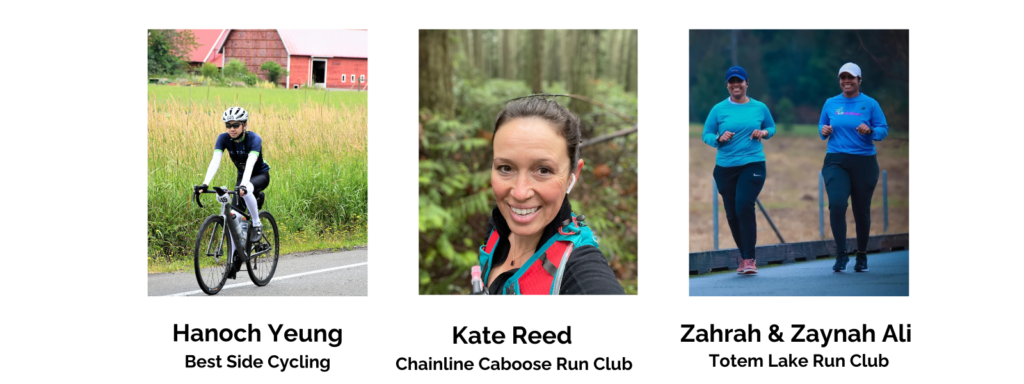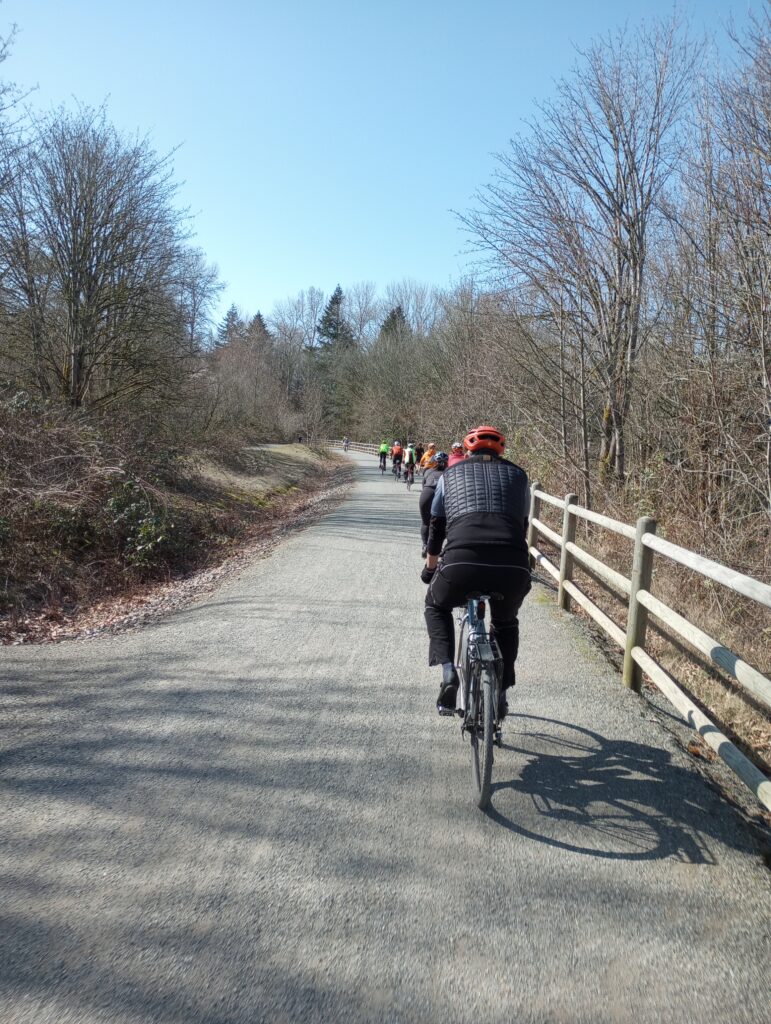Top Four Tips for Cold Weather Exercise
Year-round cyclists, runners, and walkers share what works best for them during the rainy season
Fall has arrived with lower temperatures, shorter daylight hours, and Seattle’s famous rain. If you had a regular outdoor exercise routine during the summer, you may be thinking about moving your workout indoors until spring. But you may also see people out there braving the rain, cold, and dark and you wonder how they do it.
We’ve got your back! We talked to some dedicated year-round Eastrail cyclists, runners, and walkers to bring you the top four things they do to keep exercising outside during the rainy season.


1. Mindset
It all starts in your head. “I have to always remind myself that it always looks worse when you’re standing inside your warm house than when you actually get out in the weather,” said Kate Reed, founder of the Chainline Caboose Run Club. “Once you’re out there, usually it’s fine.”
Hanoch Yeung, creator of the Best Side Cycling YouTube channel, tells himself that the hardest mile is the one up to your door. In fact, there are aspects of fall and winter biking that he actually prefers. “In the summer months it can really feel like a workout . . . but in the winter months it’s nice and cool, “Yeung said. “It can be a lot less people too, so it’s a very different vibe than the summer riding. It’s just a more chill way of riding.”
The boost to her mental health motivates Kelli Refer from Move Redmond. “There is so much beauty in biking through winter,” Refer said. “I find it helps combat seasonal depression (for me) and allows me to really enjoy the beauty of seasonal lights, evergreen trees, and moss.”
2. Light
Once you’ve gotten yourself out the door, the top priority is to be able to see and be seen. Fall and winter daylight hours are short in the Pacific Northwest, so it’s essential for everyone on the trail to carry their own lights.
Reed always wears a headlamp on her chest while running on the Eastrail. Wearing it on her chest rather than her head helps the light shine steadily forward instead of changing with every head movement.
Melody Mandrean, founder of the Totem Lake Run Club, added that runners should think about how to be visible from behind. “Particularly on the Eastrail, you need to be seen from both the back and the front because you’re going to have bikers that are coming by and commuting.” This could mean wearing something like a reflective vest, a red light on your back, or a light-up vest.
Bikes also need to be seen from all sides and should have a white front light and a red rear light. Michael Leach from Move Redmond said that setting a steady front beam is much safer because a blinking light can reduce visibility.
3. Comfort
Next you’ll need to combat the rain and cold. Whether you’re on bike or foot, just a few items can make you feel a lot more comfortable.
As a runner, Reed wears a hat to keep rain out of her eyes. “It doesn’t have to be a specialty running hat. It can just be a regular Mariners baseball hat,” Reed said. Leach said cyclists often wear a cycling cap with a brim under their helmet to help keep rain and snow out of their eyes while still maintaining visibility.
While wearing a waterproof rain jacket seems straightforward enough, it may take some time to find just the right one to fit your preference. Look for something breathable, vented, and sweat-wicking. Some can be so waterproof that they actually trap in too much heat and cause discomfort.
As for other clothing, it may take some trial and error based on personal preference to decide how covered you want to be. Mandrean recommends runners pick form-fitting items to prevent chafing. Sweat wicking fabric is also helpful because you’ll still sweat even in the cold.
For biking, Leach recommends wool socks and a matching wool base layer. “It insulates when wet, wicks well, and doesn’t smell,” Leach said. “You may not always be able to keep yourself 100% dry, but you can almost always keep yourself warm with the right clothing.” Reed says for running she treats herself to new synthetic socks every fall.
Gloves also make being outdoors much more enjoyable for cyclists, runners, and walkers alike. This can be anything from thin dollar-store gloves to higher-end wool or neoprene gloves. An alternative for cyclists is to install handlebar mittens.
Of course, shoes that are still wet from the day before (or your morning ride, if commuting) will definitely deter you from wanting to leave your house. Leach puts scrunched up newspaper in his wet shoes and places them in a warm room so they’ll be dry and ready to use.
Zahrah and Zaynah Ali are avid walkers and amateur runners in the Totem Lake Run Club. They suggested taking your shoe game to the next level by investing in a spare set of shoes or a shoe dryer. For them, these small investments have helped maintain a year-round outdoor workout routine.
Cyclists have the added worry of getting sprayed by water kicked up from their tires. The best solution is to invest in full-coverage fenders. Leach recommended installing mud flaps at the bottom of your fenders to prevent rain and street grim from spraying the rider behind you. “If your fenders don’t come with mud flaps, you can make your own out of old bike inner tubes, old rubber mats, milk jugs, and more,” Leach said.
Lastly, if you’re traveling home by car after an outdoor workout, Mandrean recommended having something cozy like a sweatshirt to change into and a hot drink in your car. “It will feel incredible!” she said.
4. Community
The last big piece of advice is to find others who will brave the cold and rain with you. This could be an organized club, or just a friend or neighbor. Zahrah and Zaynah Ali said going out in a group increases safety, helps you make new friends, builds community, and is a great way to maintain accountability.

The community aspect of local races and events can also provide motivation. “There’s just a bunch of local races that you can sign up for and then you always have something that you’re training for,” Reed said. A quick online search will bring up enough groups and events to fill your calendar.
Exercising outdoors during the rainy season can feel daunting, but these tips have helped others consistently get out the door and we hope they’ll help you too!